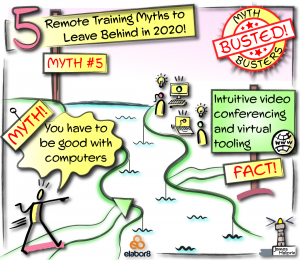These sure are strange times.
Who would have thought in their wildest dreams that the whole world would be working from home in 2020?
While the benefits of remote working have been spruiked for some time, I don’t think that even the most ardent evangelists would have predicted this scenario.
While social distancing and self isolation have certainly proved challenging, there is always a silver lining if you look hard enough. In this regard, one of the positives to come out of this episode is the rapid move to live online remote training.
Enabled by an array of affordable and powerful technologies, live remote training has been around for some time. But with the onset of the hyper distributed working environment the pandemic has triggered, there has never been a stronger focus on remote training.
But even so, there still seems to be some myths around remote training that it’s time we left behind in 2020.
So let’s jump in and set the record straight by debunking the top five myths about remote training.
Myth #1: Remote online training isn’t effective
Not all courses are made equal, and whether you’re in a face to face class or undertaking remote training, there are always the good, the bad and the ugly. However, remote learning as a delivery mechanism does not make a bad course. Rather it comes down to the quality of the content, whether the course has been designed for the delivery method i.e. in person vs online, and the quality of the trainers.
If you haven’t experienced a live online remote course previously then you’ll be pleased to know that attendees report the experience as being just as good as a face to face course and in some cases even better! Interestingly, in many countries remote online training or virtual classrooms are actually preferred.
Some of the advantages remote courses offer include shorter sessions. For example, a two day course is delivered over 3 or 4 days of shorter sessions, which also allows for more scheduling flexibility around existing commitments. And of course there is no need to travel!
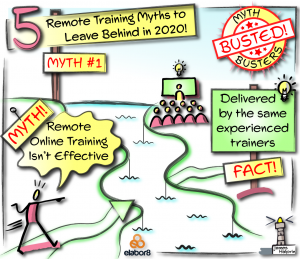
Myth #2: Remote online training isn’t accredited
Training is ultimately about learning, and if the course covers the right content and delivers the right outcomes then it should also come with the appropriate certification, irrelevant of whether the course was delivered in a face to face or online setting.
At Elabor8, all our face to face courses have been specifically designed to be delivered in a remote setting and come with the same certification as their face to face counterparts.
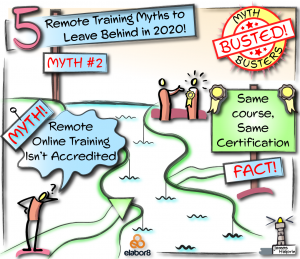
Myth #3: No interaction with fellow students
Hands up if you like being talked at for hours? I didn’t think so. Sitting in a lecture style training course is not fun for anyone and is sure to deliver limited learning outcomes.
Effective courses are designed around engaging individuals and appreciating their different learning styles. Again, this is independent of whether the course is delivered in person or online. For those of you interested in learning more about some of the training strategies that are guaranteed to deliver outstanding training results no matter what the topic, group, or learning environment, I’d highly recommend Sharon Bowman’s work, Training from the Back of the Room.
Elabor8 online courses are designed to be highly interactive and leverage technologies that allow participants to easily form teams and seamlessly go into and out of breakout rooms for the many team based activities that are essential for adult learning. Further, all remote courses will have at least one trainer or more depending on the class size, and one person helping out with the overall facilitation and ensuring the smooth running of the course.
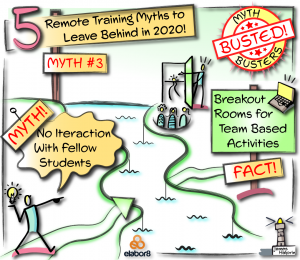
Myth #4: You can’t build a network
It goes without saying that courses are about learning. But that’s not all they’re about. They’re also about meeting new people and building social and professional networks. This is as true in face to face courses as it is in virtual classrooms.
Successful remote courses are specifically designed to deliver a rich collaborative learning experience. They deliver on this promise by ensuring that in addition to group discussions and team breakout activities, there is also plenty of opportunity to get to know everyone in the class, build those all important relationships and share contact information.
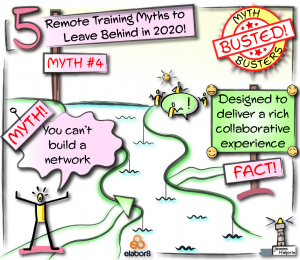
Myth #5: You have to be good with computers
Technology has come a long way since the early days of online training. Where tools were once cumbersome and harder to learn, today they are far more powerful and easier to navigate. We’ve purposely tried to select user friendly tools and only a few to keep it simple and straightforward.
There are many tools that enhance the remote training experience, some categories include:
- Video conferencing — there are now a plethora of video conferencing tools available that offer high quality video and audio, chat functions and team breakout rooms for large numbers of participants
- Virtual whiteboards — these are digital workspaces that enable teams to think and collaborate visually in real time on the many team based activities
- Online documents — digital workbooks allow participants to capture their notes throughout the course, while online documents allow teams to work on activities together and capture their output along the way
There’s no time like the present
There has never been a better time for live online remote training. The technologies that enable remote training have never been more advanced and the current hyper distributed environment has never been more conducive.
Don’t put your career on hold, take charge now to prepare yourself in an ever changing and volatile world.
Go on, what are you waiting for?
Looking for flexible learning options for your remote agile teams? Elabor8’s Academy is the only training organisation in the country certified to deliver ICAgile, Scaled Agile®, Scrum.org, LeanKanban University and Management 3.0 courses remotely.


